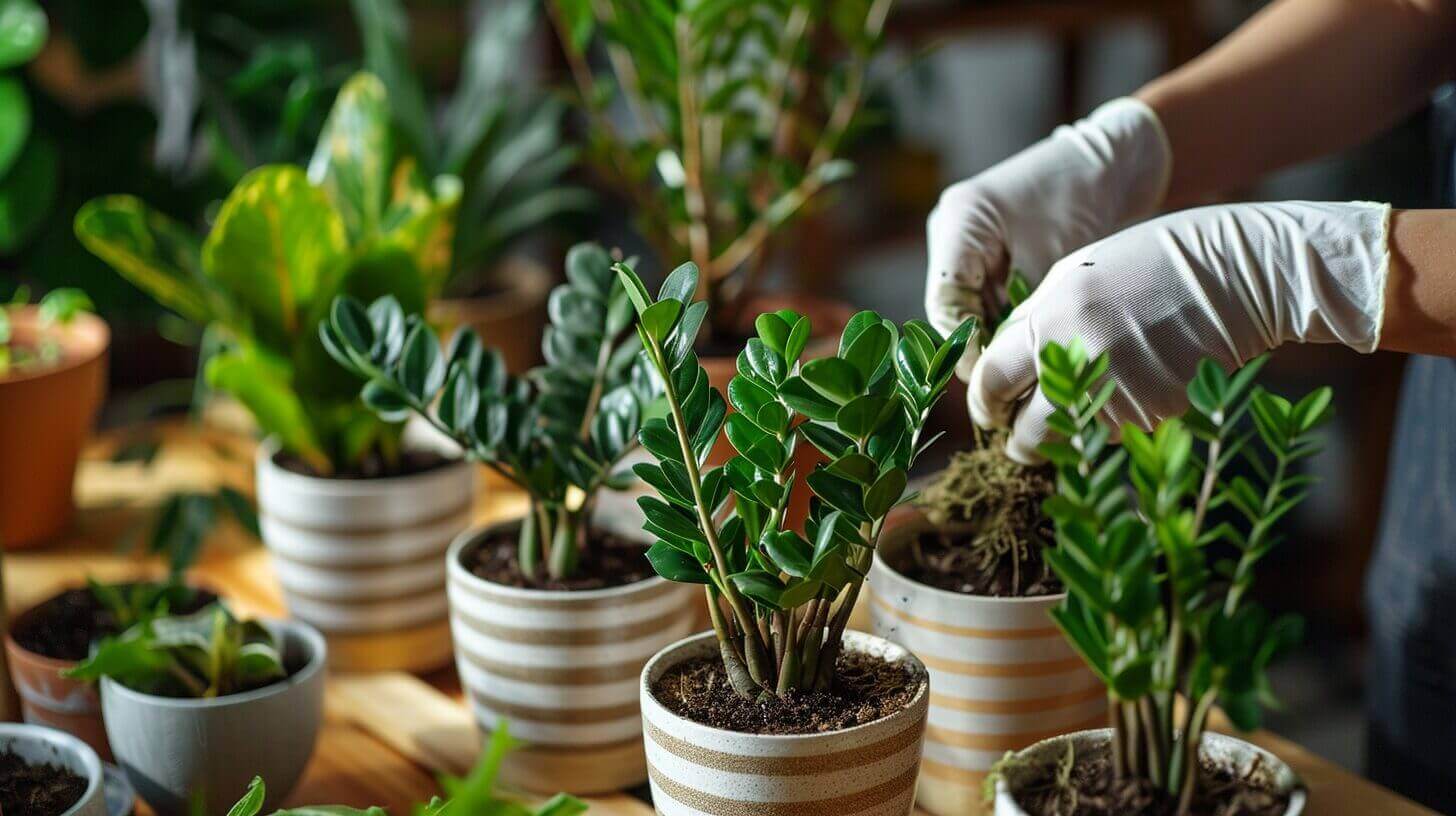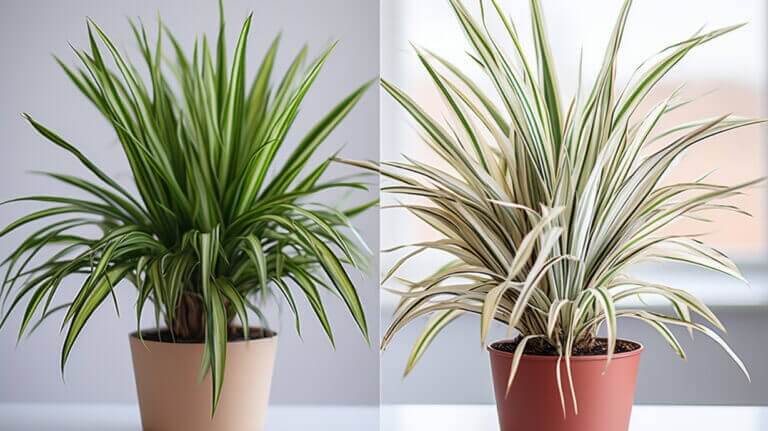How Long Does ZZ Plant Leaf Propagation Take? Step-by-Step Guide To Propagate ZZ Plant From Leaf Cutting
Are you considering propagating ZZ plant leaves but concerned about how long the process will take? Rest assured, we have all the information you need to set realistic expectations.
In this article, we will explore the factors that affect zamioculcas zamiifolia plant leaf propagation time and provide a timeline of the process. We will also discuss signs of successful propagation and address common challenges and delays that you may encounter. Additionally, we will offer helpful tips for accelerating the propagation process.
Join us as we unravel the mysteries of ZZ plant leaf propagation.
Key Takeaways
- Optimal conditions such as temperature, humidity, and light exposure greatly influence the success rate of ZZ plant leaf propagation.
- Water propagation takes 4-6 weeks and soil propagation takes 6-8 weeks for roots to develop.
- Signs of successful ZZ plant leaf propagation include the emergence of new shoots and leaves, vibrant green color and turgid texture of the leaf.
- Common challenges and delays in ZZ plant leaf propagation include inadequate moisture, improper rooting conditions, and root rot.
Factors Affecting ZZ Plant Leaf Propagation Time
What factors can potentially affect the propagation time of ZZ plant leaves? Understanding the variables that influence the time it takes for ZZ plant leaves to successfully propagate is essential for optimizing the success rate of leaf propagation. Several factors contribute to the propagation time, including environmental conditions, leaf health, and propagation method.
Firstly, the success rate of ZZ plant leaf propagation is greatly influenced by the optimal conditions provided to the leaves. Factors such as temperature, humidity, and light exposure play a crucial role in determining how quickly the leaves will develop roots. ZZ plants thrive in warm temperatures between 65-75°F (18-24°C) and prefer a moderate to high humidity level of around 50-60%. Additionally, providing bright indirect light helps promote healthy root growth.
Secondly, the health of the leaf being propagated can impact the propagation time. Leaves that are healthy, free from pests or diseases, and have a sufficient amount of nutrients stored are more likely to propagate successfully and at a faster rate. It is important to choose leaves that are mature and have a good amount of energy stored in them.
Lastly, the propagation method used can also affect the time it takes for ZZ plant leaves to propagate. The most common method is water propagation, where the leaf of zz plant in water until root in water are develop. This method typically takes around 4-6 weeks for roots to emerge. However, some gardeners prefer soil propagation, which involves planting the leaf directly into well-draining soil. This method may take longer for roots to develop, ranging from 6-8 weeks.
Timeline of ZZ Plant Leaf Propagation Process
The timeline of the ZZ plant leaf propagation process varies depending on factors such as environmental conditions, leaf health, and the chosen propagation method. Propagation techniques for ZZ plants include water propagation and soil propagation. Optimal conditions for leaf propagation involve providing the right amount of light, temperature, and moisture.
The table below outlines the general timeline for ZZ plant leaf propagation using both water and soil methods:
| Propagation Method | Timeline |
|---|---|
| Water Propagation | 4-6 weeks |
| Soil Propagation | 6-8 weeks |
During the water propagation method, the ZZ plant leaf is placed in a jar of water, and roots begin to develop. It usually takes around 4-6 weeks for visible roots to form, indicating that the leaf is ready to be transferred leaf cuttings in soil mixture.
In soil propagation, the ZZ plant leaf is placed in a well-draining potting mix. It takes longer for roots to develop in soil, usually around 6-8 weeks. Once the roots are established, new growth will appear, indicating successful propagation.
Signs of Successful ZZ Plant Leaf Propagation
Successfully propagating ZZ plant leaves often involves observing regular growth and the development of new shoots. ZZ plants, also known as Zamioculcas zamiifolia, are popular houseplants due to their low maintenance requirements and attractive foliage. Leaf propagation is a common method used to propagate ZZ plants, but it can sometimes be challenging.
To determine the success of ZZ plant leaf propagation, there are several indicators to look out for:
- New Shoots: One of the most apparent signs of successful leaf propagation is the emergence of new shoots from the base of the leaf. These shoots indicate that the leaf has rooted and is actively growing.
- Leaf Growth: Another indicator of successful propagation is the growth of new leaves from the propagated leaf. As the plant establishes its root system, it will divert energy towards leaf development, resulting in the appearance of new foliage.
- Healthy Appearance: A healthy propagated ZZ plant leaf should have a vibrant green color and turgid texture. If the leaf appears wilted or discolored, it may indicate issues with propagation, such as inadequate moisture or improper rooting conditions.
Troubleshooting ZZ plant leaf propagation can be done by adjusting factors such as light, temperature, humidity, and watering. By monitoring these indicators and making necessary adjustments, you can increase your chances of successful ZZ plant leaf propagation.
Common Challenges and Delays in ZZ Plant Leaf Propagation
Propagation of ZZ plant leaves can be hindered by common challenges and delays, such as inadequate moisture and improper rooting conditions. It is important to understand these potential issues in order to troubleshoot leaf propagation problems effectively.
One of the most common challenges faced in ZZ plant leaf propagation is inadequate moisture. ZZ plant leaves require a consistently moist environment to encourage root growth. If the moisture level is too low, the leaves may not develop roots or may take a significantly longer time to root.
Another challenge is improper rooting conditions. ZZ plant leaves need a well-draining soil mix for successful propagation. If the soil mix is too compact or retains too much moisture, it can lead to root rot and hinder the propagation process.
To troubleshoot these leaf propagation issues, it is crucial to ensure that the ZZ plant leaves are placed in a moist environment and the soil mix is well-draining. Additionally, providing bottom heat and using a rooting hormone can help accelerate the rooting process.
Tips for Accelerating ZZ Plant Leaf Propagation
To expedite ZZ plant leaf propagation, consider utilizing bottom heat and a rooting hormone, as these methods can significantly speed up the rooting process.
When it comes to accelerating ZZ plant growth and maximizing propagation, there are a few tips that can help you achieve faster and more successful results:
- Provide Bottom Heat: Placing the ZZ plant cuttings in a warm environment can promote faster root growth. Bottom heat can be achieved by using a heating mat or placing the pots on top of a warm surface, such as a radiator or heat pad.
- Use a Rooting Hormone: Applying a rooting hormone to the cut end of the ZZ plant leaf can stimulate root development. Rooting hormones contain growth-promoting substances that encourage the formation of new roots, increasing the chances of successful propagation.
- Maintain Proper Moisture Levels: It is crucial to keep the soil slightly moist during the ZZ plant propagation process. However, be careful not to overwater, as excessive moisture can lead to rotting. Regularly check the moisture level of the soil and adjust as needed.
Frequently Asked Questions
How Does Watering Techniques Affect the Propagation Process of ZZ Plants?
Maintaining proper moisture for zz plants is crucial for successful propagation. Overwatering can lead to rotting of the plant’s stems and roots, causing irreversible damage. Conversely, underwatering can hinder root development and stunt growth. Finding the right balance by following appropriate watering techniques, such as watering when the topsoil is dry, is vital for a healthy propagation process for ZZ plants.
Can Overwatering ZZ Plants Lead to Root Rot?
Overwatering ZZ plants can indeed lead to root rot, making it vital to follow the best practices for zz plant hydration. It is important to understand that ZZ plants prefer well-draining soil and require infrequent watering. Overwatering can cause the roots to become waterlogged, leading to rot and potentially killing the plant. Therefore, following proper watering guidelines is crucial for maintaining the health and longevity of ZZ plants.
Can I Propagate ZZ Plant Leaves in Water Instead of Soil?
When it comes to propagating ZZ plant leaves, one common question that arises is whether water or soil is the best method.
While both methods can be successful, there are a few factors to consider.
Water propagation allows you to observe root development, while soil propagation provides a more stable and nutrient-rich environment.
Ultimately, the choice between water and soil propagation depends on personal preference and the desired outcome.
What Is the Success Rate of ZZ Plant Leaf Propagation?
Propagation success of ZZ plant leaf propagation can vary depending on several factors. These factors include the health and maturity of the leaf being propagated, the method of propagation chosen (such as water or soil), and the environmental conditions provided.
While there is no guarantee of success, with proper care and attention, many gardeners have reported successful propagation of ZZ plant leaves.
It is important to note that patience is key, as the process may take several weeks or even months to see visible results.
How Does Watering Techniques Affect the Propagation Process of ZZ Plants?
Maintaining proper moisture for zz plants is crucial for successful propagation. Overwatering can lead to rotting of the plant’s stems and roots, causing irreversible damage. Conversely, underwatering can hinder root development and stunt growth. Finding the right balance by following appropriate watering techniques, such as watering when the topsoil is dry, is vital for a healthy propagation process for ZZ plants.
Should I Use Rooting Hormone When Propagating ZZ Plant Leaves?
When propagating ZZ plant leaves, one may wonder whether to use rooting hormone. Although not necessary, using rooting hormone can enhance the success rate of propagation.
Rooting hormone contains growth-promoting substances that encourage root development, resulting in quicker establishment of new plants. However, there are also alternative methods that can be used instead of rooting hormone, such as water propagation or using natural alternatives like aloe vera gel.
Ultimately, the decision to use rooting hormone depends on personal preference and desired outcomes.
What is ZZ plant propagation?
ZZ plant propagation is the process of creating new ZZ plants from the parent plant. This can be done through stem cutting, leaf cutting, or root division.
How can I propagate my ZZ plant using a stem cutting?
To propagate your ZZ plant using a stem cutting, cut a healthy stem from the main plant. Place the cutting in water or potting soil and wait for it to root.
Can I also use a leaf cutting for ZZ plant propagation?
Yes, you can use a leaf cutting to propagate your ZZ plant. Simply cut a healthy leaf and place it in soil or water. It may take a long time, but a new rhizome will eventually grow.
What is the best propagation method for a ZZ plant?
The best way to propagate a ZZ plant is through stem or leaf cuttings. This method is one of the easiest and most successful.
Can I root a ZZ leaf in water?
Yes, you can root a ZZ leaf in water. Just make sure to change out the water every few days to prevent rot.
What is root division in terms of ZZ plant propagation?
Root division involves separating the rhizome and roots of the ZZ plant into several parts. Each part can then be planted in its own pot to grow a new ZZ plant.
How should I pot my newly propagated ZZ plant?
Once your ZZ plant cutting has rooted, you can pot it in a mixture of potting soil and perlite for drainage. Make sure the pot has holes at the bottom for excess water to escape.
What is a rhizome in the context of a ZZ plant?
A rhizome is an underground stem from which the ZZ plant grows. It stores water and nutrients for the plant and can be used for propagation.
Can I keep my ZZ plant cutting in water indefinitely?
While you can root your ZZ plant cutting in water, it’s best to transfer it to soil once it has developed roots. Keeping the cutting in water for too long can lead to root rot.
Is the ZZ plant a good houseplant?
Yes, the humble ZZ plant is one of the best houseplants you can have. It’s easy to care for, can tolerate low light conditions, and has air-purifying properties.
What does Zamioculcas zamiifolia mean?
Zamioculcas zamiifolia is the scientific name for the ZZ plant. It’s native to eastern Africa and is known for its glossy green leaves and easy care.
How often should I repot my propagated ZZ plant?
You should repot your propagated ZZ plant when it outgrows its current pot or when the soil becomes depleted of nutrients. This typically happens every 1-2 years.
Can I propagate my ZZ plant outdoors?
While it’s possible to propagate your ZZ plant outdoors, they are typically propagated indoors where conditions can be more easily controlled.
How do I know if my propagated ZZ plant needs more water or soil?
If your propagated ZZ plant’s leaves start turning yellow or wilting, it may need more water. If growth seems stunted or slow, it may need more nutrient-rich soil.
Can I place my propagated leaves in soil directly?
Yes, you can place your propagated leaves in soil directly. Just make sure to let the cut end dry out for a day or two before planting to reduce the risk of rot.







